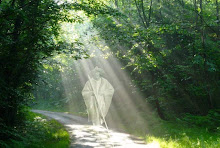“The Historical Path”
Legend has it that after Jesus was crucified, Saint James, one of the 12 Apostles, went to Spain to convert the local people. Upon his return to Jerusalem he was promptly beheaded by King Herod Agrippa, making him the first Apostle to be martyred. James' followers secreted his body away in a boat, and sent it back to Spain where they buried it. It lay hidden for several hundred years.
In 813 AD a curious hermit followed "sweet music and twinkling stars (The Milky Way) to a remote field in Galicia, in northern Spain. There he discovered what was to be identified as the tomb of Saint James. King Alphonso II of Spain visited the site, built a church and monastery over the tomb and declared St. James (Santiago) the patron saint of Spain.
Pilgrimages to the site began, and by the ninth century, the number of Pilgrims rose over the years, and peaked in the eleventh and twelfth centuries, when about a half million people made the pilgrimage. Many of the towns and cities along the Camino were built at that time. Most of these ancient villages have changed very little over the centuries. Around 1500AD the number of Pilgrims dropped off significantly because of reformation, political reasons and other factures. But In 1982 Pope John Paul II visited Santiago de Compostela and popularity soared once again and has grown steadily since then.
The Gospel tells us that James, son of Zebedee, was in his boat mending nets with his brother John, when Jesus summoned them, saying, "Follow me and I will make you a fishers of men". James and his brother did follow Jesus. If one considers that today 100,000 people a year make the pilgrimage to Santiago de Compostela to visit his burial place, it would seem that James is still "a fisher of men" over 2000 years later. It is my hope to follow in St. James' footsteps.
So with this in mind, I seek out the “Santiago Spirit.”
Subscribe to:
Post Comments (Atom)
.jpg)

No comments:
Post a Comment